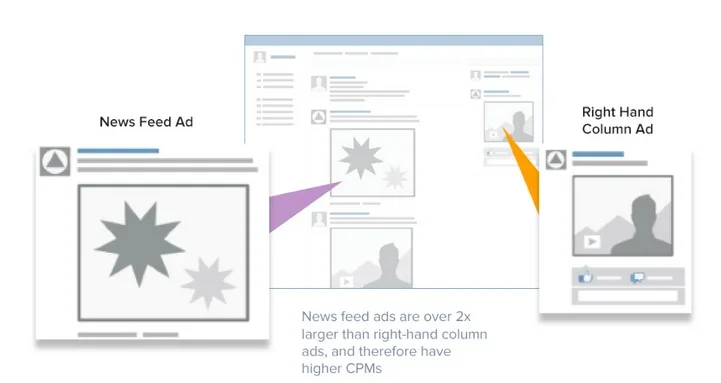The 7 Must-Measure Facebook Ad Analytics to Increase Your ROI

Facebook reporting gives marketers a whopping 145 metrics to look at, and yet, Facebook reporting is only half of the equation when it comes to understanding if your Facebook ad spend is reaping you positive ROI.
In comparison to the likes, shares and clicks your Facebook ad generates, the activity that occurs on your site including checkout conversions and new customer signups are equally, if not more, important to how you evaluate the overall success of your advertising campaign.
To help you better understand the business impact your Facebook ads are driving, here are the seven essential metrics every Facebook advertiser should know and measure.
Impressions
This is defined as the number of times your ad is shown. More impressions lead to higher brand awareness for your company. If you’re reaching new customers, promoting an attitude about your brand or launching a new product, brand awareness should be one of your top priorities.
Aside from the number of impressions, you should also consider the placement of your ads. Ads in the news feed are more than double the size of the right-hand column ad. Accordingly, the news feed ads are more impactful and likewise more expensive.

Speaking of expensive, you should also look at the cost per thousand impressions (CPM) of your ads. If two ads are being shown in the same placement, spend more on the ad with a lower CPM, so you can reach more people for less.
Here is how you calculate CPM:
CPM = ad cost x 1,000 / # of impressions
Clicks
This is defined as the number of times your ad is clicked on. Clicks are a way to measure customer engagement and level of interest. The number of clicks tells you how many times people came to your website because of your ads.
Put clicks in context by measuring the number of clicks divided by the number of impressions, or the click-through rate (CTR). The higher the CTR, the more interested people are in your ad.
Here is how you measure CTR:
CTR = # of clicks / # of impressions
Also look at the cost per click (CPC) of your ads. If your objective is to drive as much interest as possible at the cheapest cost, you want to spend more on ads with lowers CPCs.
Here is how you measure CPC:
CPC = ad cost / # of clicks
Similar to measuring the impact of impressions, remember that the placement of your ad makes a big difference on your CTR and CPC. Ads shown in the news feed generally have higher CTRs and higher CPCs than those in the right-hand column. News feed ads are larger in size and mixed in with a user’s organic content. Many people may click on news feed ads without realizing they are even ads.
Keep in mind that clicks are just a proxy for interest. Even if someone is interested in your product, they may not click on your ad because they are averse to doing so. Instead, they may view your ad and visit your website at a later time.
Conversions Metrics
Conversions refer to actions taken on your website. This could mean different things to different businesses. In general, it refers to the desired action you want to take place. For example, it could refer to adding a product to a cart, checking out or entering an email address.
Put conversions in context by measuring the number of conversions divided by the number of page visits, or conversion rate. Your conversion rate indicates how likely it is that a visitor will take the desired action. When considering what to advertise, choose products that have a high conversion rate. Also, keep in mind that a higher CTR does not equate to a high conversion rate.
How you measure conversion rate:
Conversion rate = # of conversions / # of clicks
A metric that many marketers use to determine advertising effectiveness is the advertising spend divided by the number of conversions, or cost per action (CPA). The lower the CPA, the more conversions you are getting for less.
How you measure CPA:
CPA = ad cost / # of conversions
When looking at conversion metrics, make sure to acknowledge the source. If a user receives an email from you, he or she is already familiar with your product and is more likely to take an action than a brand new customer. A user coming from a Facebook ad may be less familiar with your product and will likely have a lower conversion rate.
Return on Ad Spend (ROAS)
Return on ad spend (ROAS) is defined as revenue divided by advertising spend. This metric should be used for advertisers looking to drive sales immediately. The higher the return on ad spend, the better. Most advertisers look to at least break even on their advertising campaigns with a ROAS greater than 100%. If you look at lifetime value, though, you can afford to have a lower ROAS target.
How you measure ROAS:
Return on Ad Spend (ROAS) = revenue / ad cost
When evaluating your ROAS results, make sure to consider your advertising budget and click volume. We recommend getting at least 100 clicks on an ad before assessing your ROAS performance.
Keep in mind that if your goal is to build brand awareness or drive engagement, ROAS should not be their primary metric. Revenue is important, but new customers from a branding campaign are just starting to learn about your business. It will take time to nurture their interest before they make a purchase.
Lifetime Value
Lifetime value is the projected revenue that a customer will generate during their lifetime. Advanced marketing teams typically set a goal for the cost to acquire new customers to be less than the profit margin generated over the course of a year from those customers.
Here’s how it works:
Let’s say you spend $100 on Facebook advertising and 10 people join your email newsletter. In the first month, one person buys an item for $25. In the second month, two people buy items totaling $50. In the third month, five people buy items totaling $125. In three months, you’ve generated $200 from the people who joined your email newsletter. Since you spent $100 in ads, you have generated a 100% ROAS.
If you only looked at revenue from the first month in this scenario, though, you would greatly underestimate the value of your advertising.
In all, a report from BIA/Kelsey found that 75% of SMBs use advertising on social networks to help increase sales and awareness of their online store. With 90% of Facebook’s $12.2 billion revenue in 2014 attributed to advertising, money allocated to social ads should be well spent –– and these metrics will ensure that your ad dollars are generating real customers.
Photo: Flickr, Facebook(let)

Tracey is the Director of Marketing at MarketerHire, the marketplace for fast-growth B2B and DTC brands looking for high-quality, pre-vetted freelance marketing talent. She is also the founder of Doris Sleep and was previously the Head of Marketing at Eterneva, both fast-growth DTC brands marketplaces like MarketerHire aim to help. Before that, she was the Global Editor-in-Chief at BigCommerce, where she launched the company’s first online conference (pre-pandemic, nonetheless!), wrote books on How to Sell on Amazon, and worked closely with both ecommerce entrepreneurs and executives at Fortune 1,000 companies to help them scale strategically and profitably. She is a fifth generation Texan, the granddaughter of a depression-era baby turned WWII fighter jet pilot turned self-made millionaire, and wifed up to the truest of heroes, a pediatric trauma nurse, who keeps any of Tracey’s own complaints about business, marketing, or just a seemingly lousy day in perspective.


